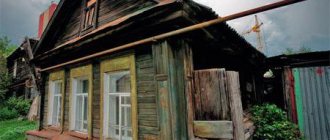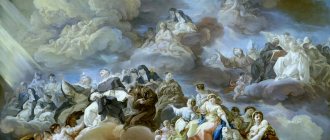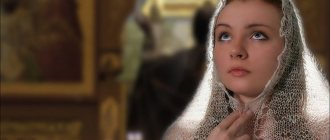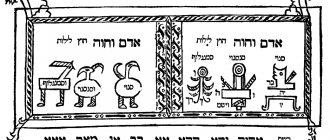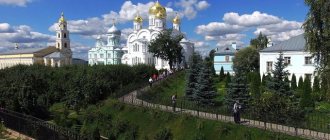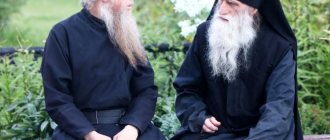This incident occurred in the winter, on New Year's Eve 1955–1956, in the city of Kuibyshev, now Samara. Klavdia Bolonkina and her son lived in house number 84 on Chkalova Street. To celebrate the New Year, my son invited friends to visit. Among the invitees was Zoya Karnaukhova, who the day before met a young intern named Nikolai, who promised to come to them for the holiday (According to another version, the incident occurred in the house where the young girl Zoya lived with her mother. The mother asked her daughter not to have noisy celebrations that night and go to church for a night service. Zoya refused and invited her girlfriends and boyfriends to the celebration. In the evening, Zoya’s mother went to church, and Zoya remained to wait for the guests to arrive). All the friends were with the guys, Zoya was sitting alone - Nikolai was delayed. When the dancing began, she said: “If my Nikolai is not there, I will dance with Nikola the Pleasant!” And she headed to the corner where the icons stood. The friends were horrified: “Zoe, this is a sin,” but she said: “If there is a God, let him punish me!” She took the icon and pressed it to her chest. She entered the circle of dancers and suddenly froze, as if she had grown into the floor (According to the recollections of some eyewitnesses, for a moment, a terrible rumble and noise appeared in the house, it became as bright as day). The guests, frightened, fled, and Zoya remained standing on the wooden floor, clutching the image of St. Nicholas the Wonderworker to her chest. It was impossible to move it from its place, and the icon could not be taken out of hand - it seemed to be stuck tightly. The girl showed no external signs of life, but her heartbeat and pulse were normal.
The whole city quickly learned about the event. In the first days, a lot of people crowded around the house, wanting to look at the petrified girl with the icon. However, soon the police closed the house from annoying onlookers and stationed guards. The police were afraid to approach the immobilized Zoya. According to some reports, several police officers who participated in cordoning off the house turned gray for no reason and very quickly (From the recollections of police officers, an old man walked near the house for three days, asking the guards to let him into the house. But the guards were adamant, only on the third day , they let him in. The elder’s words were heard from the house: “What, is my daughter tired of standing?” These words were spoken with such affection and love that the guards did not disturb the conversation between the elder and Zoya. After some time, entering the house, the police did not find strange old man, it was as if he had never entered).
The arriving doctors were unable to carry out the necessary actions to resuscitate the girl. The injection needles bent and broke, and the girl’s skin was cold and hard as stone. When they tried to move Zoya to bed, nothing happened. It was as if she and the floor were one. The girl with the icon was left alone.
When a mother came from church and, seeing her daughter in this position, lost consciousness. She was taken to the hospital. Upon returning, the mother began to pray for her daughter, day and night, without ceasing.
At her mother’s request, priests began to come to Zoya, but they also could not help. After some time, Hieromonk Seraphim appeared in the house of the desperate mother (according to different versions, we are talking about Seraphim Tyapochkin, Seraphim Poloz or Seraphim Zvyagin), who served a prayer service in the house and consecrated the house, after which he was able to take the icon from Zoya’s hands and predicted, that her standing will end on Easter Day.
On the night of the Holy Resurrection of Christ, unexpectedly for everyone, those present heard Zoya praying. From that night on, her feelings returned and she was able to leave the place. She was laid on the bed, where the girl continued to cry out for prayer for her sins and the deeds of sinners. Zoya screamed in a frantic voice every night. She asked people to pray and ask the Lord for forgiveness of sins committed during life.
Zoya stood silent and motionless for 128 days, without food or water, and died on the third day of Easter.
Still from the feature film “Miracle” (2009)
The rector of the Church of the Kazan Icon of the Mother of God in the village of Neronovka, Samara region, Father Roman Derzhavin states:
“Zoya’s Standing” is a fact that actually took place. My father told me this story. The miracle happened more than 50 years ago, in January 1956. Pipe plant worker Zoya Karnaukhova celebrated the New Year holidays with friends. Her believing mother forbade her daughter to have fun during the Nativity Fast.
— Website "Samara Today"
Otherwise, the story told by the abbot repeats the events described above.
According to Samara journalist Erofeev, in January 1956, crowds of thousands began to gather at house No. 84 on Chkalov Street because of rumors about a “petrified” girl in the house. Police posts were posted near the house, but even more people began to gather. The security of the house was strengthened by mounted police. The journalist does not have reliable information about what actually happened in the house.
The presence of rumors, excitement, police posts, and then mounted police is confirmed by the transcript of the 13th regional conference of the CPSU, held on January 20, 1956, where Mikhail Efremov spoke (in 1952-1959, first secretary of the Kuibyshev regional committee of the CPSU).
Hello dear authors, subscribers, readers of my publications!
Today I decided to write an article about the “miracle”, which, as the Orthodox legend says, happened in the city of Kuibyshev (now Samara) in 1956, on Chkalov Street at house number 84. Namely, we will talk about an amazing and for many, inexplicable case, or maybe just about false rumors, pious old grandmothers. The story is certainly fascinating, interesting, mystical. But..Was there even this “Zoino’s standing?” On your marks:
Screen: from the film “MIRACLE”, 2009.
NEIGHBORS: NIKOLAI BECAME A RECIDIVIST
As it turned out, in the house on Chkalovskaya, 84 in 1956, it was not Zoya and her mother who lived, but her fiancé Nikolai and his mother Klavdiya Petrovna Bolonkina. After those events, as Klavdia Petrovna’s acquaintances say, she became withdrawn. A few years later she moved to Zhigulevsk, where she died 20 years ago.
Young Nikolai started drinking heavily and went down a slippery slope. He was in prison several times, once he escaped, and the police ambushed him in that very house. In the end, Nikolai, as an incorrigible alcoholic and repeat offender, was sent to the countryside, where he soon died.
As the legend says!
On the New Year holidays of 1955 - 1956, a young pipe factory worker Zoya Karnaukhova, in the company of friends, was waiting for her beau Nikolai. This happened in the house of Claudia Bolonkina. On New Year's Eve, Claudia's son invited friends. Friends came, and Zoya too, but Nikolai lingered... After some time, everyone split up into pairs and the dancing began. Nikolai never showed up. Again, as the legend says, Zoya went up to the icons and said: if my Nicholas is not there, I will dance with St. Nicholas the Pleasant! They tried to dissuade her, saying it was a sin, God would punish her, etc... But Zoya replied, if there is a God, let him punish her! Zoya took the icon and, pressing it to her chest, entered the circle of dancers and turned to stone. It was impossible to move it from its place, and the icon could not be taken from hand. The girl showed no signs of life, but her heart was slightly audible. The doctors could not give an injection because the skin was oak. Rumors spread quickly and onlookers began to arrive at the house on Chkalov Street. The crowd grew, tram traffic was blocked, and the house was uncoupled by police, including mounted ones. There is information that they wanted to cut down the floor along with Zoya, but it didn’t work out as blood started gushing out of the floor... Horrible!)
“Zoe’s Stand” or size matters
For some reason, none of the believers in the “miracle” pay attention to a completely obvious fact: Bolonkina’s house is of very modest size. These are three tiny rooms in which you can, of course, get drunk individually, but it is absolutely impossible to organize a party with dancing.
View of Claudia Bolonkina’s house from the depths of the courtyard.
The room where the dancing allegedly took place, with fatal consequences for one of the participants, measures about 12 square meters. Add furniture there - a table, chairs, a certain bedside table with a certain gramophone, to which the walkers allegedly danced, or an accordion player with an instrument sitting, say, on a bed - and it becomes completely clear that one couple can somehow waltz in such a tiny space , but a few people – no way. Unless, of course, they are dancing a lambada...
All that remains of one of the rooms in the house of Claudia Bolonkina
In 2007, the State Television and Radio Broadcasting Company “Samara” aired the documentary film “Stone Zoya” as part of the television cycle “Collected Works”. The 15-minute program was filmed over several months, and journalist Galina Shcherba worked on it. At this time, Bolonkina’s former house had long been rented out, there were no eyewitnesses left, and the residents of the neighboring houses were so tired of endless questions that at the mere mention of the name “Zoya” they were ready to slam the door in front of those interested and lock the gate...
Living conditions in these houses still remain at Stone Age levels.
They can be understood - the living conditions in these houses still remain at the level of the Stone Age: without sewerage, without running water, without major repairs. They would like to solve their problems with the help of journalists, but as luck would have it, they only ask about the stone girl... However, the film crew then managed to get into the house. The tenant even kindly pulled back the rug and showed the floorboards. But it was obvious that it was impossible to turn around in the little room. Judge for yourself - we made a cut from shots of the house and room that were then included in the program.
Before this, Samara local historian Valery Erofeeva also noted the modest size of Bolonkina’s home, and according to neighbors, Claudia never had drinking parties and generally lived quietly.
The windows of Bolonkina's former house are boarded up. According to residents, prayers are held here from time to time.
Well, we will introduce you to the rest of the irrefutable facts later. Although the main “fact,” in our opinion, is the attitude of the Russian Orthodox Church to the house of Claudia Bolonkina. The house in which the “miracle” happened is NOT NEEDED by the Russian Orthodox Church. Relatively recently, it burned, and now it is quietly living out its life, awaiting demolition. Although it could become a center of mass pilgrimage. But it won’t, since there are no people willing to buy land for the appropriate purposes. Why? Perhaps you have the answer to this question.
PS By the way, what do they want to do in the former house of Klavdia Bolonkina? Read the link.
We give badges for comments. Details at the link
Is the nurse's story true?
Anna Kalashnikova, at that time worked as an emergency nurse and was on this call. Priest Vitaly Kalashnikov is a relative of Anna, explained in an article by Komsomolskaya Pravda. He assures that their entire family was very frightened by that story. It was supposedly like this:
In the morning she came to our house and said the following: You are sleeping here, but the city has been on its feet for a long time!
And she told about the “miracle”.
She also said (although she gave a subscription) that she saw a petrified girl with an icon of Nicholas. I tried to give an injection, but the needles were bent.
Everyone was shocked by the story. Anna worked as a doctor for many more years. Anna died in 1996.
Photo: Legendary house on Chkalova!
PARTIES: THE POLICEMAN GOES GRAY FROM FEAR
Many believers in Samara know pensioner A.I. Fedotova.
“In those days, I was near Zoya’s house twice,” says Anna Ivanovna, “I came from afar. But the house was surrounded by police. And then I decided to ask some policeman from the security about everything. Soon one of them - a very young one - came out of the gate. I followed him and stopped him: “Tell me, is it true that Zoya is standing?” He replied: “You ask exactly like my wife. But I won’t say anything, it’s better to see for yourself...” He took off his cap from his head and showed his completely gray hair: “See?!” This is truer than words... After all, we gave a subscription, we are forbidden to talk about it... But if you only knew how scary it was for me to look at this frozen girl!
Another 1 priest approves!
The rector of the Church of the Kazan Icon of the Mother of God in the village of Neronovka, Samara region, Father Roman Derzhavin states:
“Zoya’s Standing” is a fact that actually took place. My father told me this story. The miracle happened more than 50 years ago, in January 1956. Zoya celebrated New Year's holidays with friends. Her pious mother forbade her daughter to have fun during Lent, and God punished her for dancing with the icon!
Photo: YouTube source.
To a foreign monastery: saints in the struggle for land and property
Another area that the saints did their best to protect was the property of the church, and in particular the monasteries. A striking example is “The Tale of the Life of Mikhail Klopsky,” compiled in the second half of the 15th century on the basis of earlier legends. Mikhail, a relative of Dmitry Donskoy, took upon himself the feat of foolishness, renounced his high position and became a monk of a monastery near Novgorod. Even during his lifetime, he had the ability to cause a variety of ailments in his opponents, and the reason for this was mainly economic conflicts.
It happened like this: having learned about the offense, he “predicted” a certain misfortune for the rule-breaker - and it was immediately brought to life. Most often, Mikhail's opponents were overcome by paralysis. This happened with the Novgorod mayor Grigory Kirillovich, who forbade the monks to fish in the nearest river, since it flowed through his lands. He threatened to break the arms and legs of those who did not obey, but, according to Mikhail, the limbs were taken from Gregory himself. The mayor’s health returned only a year later, when Mikhail allowed him to serve in the Klopsky monastery. In addition, the holy fool was subject to heart disease, dumbness, and memory loss.
Judging by the text of the Tale, the severity of the punishment did not depend on the scale of the crime. The only thing that unites all the victims is that they tried to encroach on the property of the Klop Monastery and the church as a whole. The social status of the attackers did not matter either: simple robbers who entered the monastery with weapons, the priest-thief, the Novgorod boyars who laid claim to church lands, and even the Novgorod archbishop who imposed a “tax” on the monks, that is, wanted to receive money from them.
Historian Alexander Medved notes:
“A modern reader of the life may get the feeling that Mikhail Klopsky did not always act on behalf of God - too often he used his gift of suggestion when resolving rather ordinary, as they would say today, disputes between “economic entities.”
Nevertheless, the compiler of the life clearly believed that the highest justice was on the side of Michael. As soon as the mayor has barely come to his senses, the future saint says: “God will punish the one who starts the army!” - and the scribe clearly agrees with him.
There are similar episodes in Western European lives. For example, the already mentioned Herald of Avrilak, who also came from an influential family, had to defend the monastery from his own nephew. He, together with his people, decided to rob the monastery located on his uncle’s lands. Saint Gerald appeared to the wicked man in a dream, hit him on the head and threatened him with immediate death if he did not leave the monks alone. Later, several more people encroached on the monastery property, and they all died under terrible circumstances: say, the skin of a boy who stole an altar cover from a church was completely peeled off.
Matthew Kuefler, who studied the life of the Herald, believes that there is something more behind specific property disputes, even ordinary ones. He writes that these episodes reflect the turbulent situation that surrounded the monasteries in the Middle Ages. Their lands and property were the object of constant “hunting” both from the nobility and from commoner robbers. It is not surprising that the monks had to defend themselves. The strength of earthly patrons was not always enough, and the reputation of a merciless saint, ready to stand up for his monastery, came to the rescue.
The CPSU has rebelled!
Local communist authorities decided that all these rumors were a provocation, specially prepared for the regional party congress. The local newspaper “Volzhskaya Kommuna” even published a feuilleton entitled “Wild Case” dated January 24, 1956. The editor personally ridiculed this hype around the supposed “miracle.”
Data given in the newspapers “Moskovsky Komsomolets” and “Komsomolskaya Pravda” say that Zoya’s story is probably a fiction of Claudia Bolonkina. The first secretary of the Kuibyshev regional committee of the CPSU in 1952-1959, Mikhail Efremov, tells the following about the event:
For sleeping and drunkenness: punishment for disrespect
Another type of situation where saints could show a harsh disposition was when a person treated them with disrespect. Then the saints took rather harsh measures to point out the mistake to the insolent people, and at the same time to those around them. The Lives do not skimp on terrible details in order to impress the reader and instill in him awe of the image of the saint.
Studying the sources, one can notice how broadly their compilers understood disrespect for saints. For example, we find a characteristic episode in the same life of Leonty of Rostov: these events occurred many years after his death, when Leonty had already been canonized. Once on the day of his memory, a miracle happened - at night the saint rose from the tomb, the church where he rested was filled with fragrance, and angelic singing sounded in it. By morning, the candle at the tomb, lit by the angels, continued to burn. After the service, one of the church ministers wanted to extinguish it and was immediately punished: he became deaf and numb, his arms and legs stopped moving. The cleric recovered only after he repented of all his sins.
However, the saints did not always send illness for disrespect; sometimes it was enough to ignore the person’s requests. This was the fate that awaited the lame boy who visited the tomb of St. Thomas Becket in the hope of being healed. To turn to the saint, the young man had to lie down on the slab covering the tomb - this was the traditional method of healing at the saint’s grave. Alas, lying on the stove, the tired boy soon fell asleep. Thomas Becket appeared to him in a dream, cursed the sick man for his insolence, and then declared that he refused to grant him health.
The saints punished Christians not only for disrespect for them personally, but also for violating the rules established by the church. For example, the life of Martin of Tours tells about a woman who, contrary to the ban, worked on Sunday. Her hand became numb, and her fingers did not leave her palm until the offender came to church and vowed never to work on the holy day again.
Believers could also suffer for their careless attitude towards church holidays. Such a case is described in the Volokolamsk Patericon, a collection of stories about the servants of the Joseph-Volokolamsk Assumption Monastery. One day a company of lay neighbors gathered to properly celebrate the day of the apostles Peter and Paul. The friends brewed mead, and one of them came up with the idea to start celebrating even before the church service. Having drunk quite a bit, he saw a man with a black beard and a noticeable bald spot, “with a terrible look.” The stranger hit the mead maker on the cheek so hard that five of his teeth fell out and the drunkard “lay like dead” for a long time, almost completely paralyzed.
Having barely come to his senses, he told his loved ones about what had happened, and they, based on the description of the terrible man, guessed that it was the Apostle Paul himself - he is usually depicted as bearded and almost bald. The unfortunate drunkard never recovered, and his relatives took him to a monastery, where he died a year later.
From the transcript of the 13th regional conference of the CPSU dated January 20, 1956:
“Rumors spread in Kuibyshev about an alleged miracle that happened on Chkalovskaya Street. Yes, such a miracle happened, shameful for us communists...
Some old woman walked and said: young people were dancing in this house - and one woman began to dance with the icon and became petrified, stiff... The devout old women began to ring out, with their additions about the miracle. And off it went, people began to gather... A police post was immediately set up. Where the police are, there are onlookers. Mounted police were deployed. They wanted to send priests there to eliminate this shameful phenomenon. But the regional committee bureau decided to remove all posts; there was nothing to guard there. It was stupid, there were no dances, an old woman lives there.
CHURCH: THE PRIEST WAS NOT ALLOWED TO SEE ZOE
The elder of the Ascension Cathedral, Andrei Andreevich Savin, shares his memories:
“At that time I was the secretary of the diocesan administration. The Commissioner for Religious Affairs Alekseev calls our Bishop Jerohim and says: “We need to announce to the people in the church from the pulpit that nothing happened on Chkalovskaya.” In response, the bishop asked to let the rector of the Intercession Cathedral into the house so that he could see for himself. The representative said: “I’ll call you back in two hours.” And he called only two days later and said that he did not need our services. So none of the clergy were allowed there. The talk that Zoya was visited by Hieromonk Seraphim is not true...
And the crowd was shown a small empty room and said: “You see, there is no one there.” People asked to see a large room. “They have things piled up there, there’s nothing to see,” the authorities assured. These days, teams of Komsomol members worked on city trams, convincing people that they were in the house and did not see any frozen girl.”
A scam of that time from Claudia Bolonkina!
House No. 84 belonged to Claudia Bolonkina, and the names of Zoya Karnaukhova and monk Seraphim were not found in the archives at all. Eyewitnesses said that there really were dances with the icon. A nun passing by said: “For such a sin you will turn into a pillar of salt!”, and Claudia began to spread rumors that this was what happened.
There is information that Claudia liked this story so much that she decided to make money from it. She agreed with her neighbor to stand with the icon, and for 10 rubles Claudia let everyone in to see the “miracle” from afar... not bad... for that time! And when Zoya supposedly came to life, Claudia came up with an even cooler idea! The neighbor with this icon screamed as if she had not yet been cut off at night: Pray people... the earth is on fire, put on crosses and so on... Well, how can you not believe it!?) At this moment, devout, but in fact crafty Claudia, not bad, as They would say right now that she advertised a “miracle” in favor of the church! As I wrote above, people flocked to the church to be baptized, etc... So a couple of pious old women put the whole Kuibyshev (!) on their ears.
In 2009, the diocese turned to the city authorities with a request to establish a memorial sign in honor of the Samara miracle. In 2012, a monument to Nicholas the Wonderworker was erected on Chkalov Street.
Film adaptations
Based on this story, in 2000, the Samara studio “35 mm” made a twenty-minute documentary film “Zoya’s Standing”. Anton Zhogolev, Vadim Frenkin, Vladimir Osipov, Dmitry Oderusov, Yuri Izyatsky worked on the film.
In 2009, the feature film “Miracle” was released, directed by Alexander Proshkin based on the story of “Zoya’s Standing”. The script for the film was written by Yuri Arabov. The film stars Konstantin Khabensky, Sergei Makovetsky and Polina Kutepova.
In 2015, a three-part television film “Zoya” was shot based on the play “Zoya’s Standing” by Alexander Ignashev (directed by Alla Korovkina, starring Samara theater actors Anastasia Ermilina, Yuri Mashkin, Mikhail Akaemov.
This is how Lyubov Kabaeva, a resident of a neighboring house, remembers this “miracle”:
All this is nonsense! I myself was still a girl in those years, but my late mother remembered everything well and told me. Either a monk or a priest once lived in this house. And when persecution began in the 30s, he renounced his faith, sold his house and left. But religious people often came here and asked where he was, where he had gone. And on the very day when Zoya allegedly turned to stone, there really was a dance in the Bolonkins’ house. And as luck would have it, another nun arrived that same evening. She looked out the window and saw a girl dancing with an icon. And she went through the streets wailing: Blasphemous! You'll turn to stone! Yes, you are already petrified!
Someone heard, picked it up, and off we go.
The next day, people came to the Bolonkins - let's show the stone woman!
When people finally got to her, she called the police.
They set up a cordon. Well, what about the people? If they don’t let you in, it means they’re definitely hiding something. That's all "Zoino's standing."
KGB: IT WAS A RUMOR
With the help of the press center of the regional FSB department, we managed to find an eyewitness to those events from the KGB.
Mikhail Egorovich Bakanov says:
“At that time I was a senior commissioner of the KGB. The authorities sent me to look into that very house on Chkalovskaya. There I saw cunning men who, for a chervonet, promised to take those who wanted to the house and show them the petrified maiden. Yes, no one stopped them from entering. I myself led several groups of curious people into the house, who confirmed that they had not seen anything. But people did not leave. And this outrage continued for a week. I don’t remember whether I talked to Zoya herself or not. So many years have passed."
Another eyewitness, an employee of the Samara Labor Inspectorate Valery Borisovich Kotlyarov, considers all this an invention of the “churchmen”: “I was a boy then. We boys were not allowed into the house. And the police brought in 10 adults. When they came out, they said: “There is no one there.” But the people did not leave... I saw a truck with pipes driving down the street and, when turning around, injuring several people with its load. And the pilgrims gossiped: “This is God’s punishment...”
STONE GUEST
60 years ago, in January 1956, thousands of people began to come to Chkalova Street in Kuibyshev after hearing about the petrified girl. DG collected information about what happened from various sources and presented it as briefly as possible.
What is known for sure about the January events of 1956. In the tenth day of January, townspeople began to gather at houses No. 86 and 84 on Chkalova Street, having heard about a woman petrified in one of the houses, whom visitors and residents during this period called “the stone girl.” According to various estimates, from a thousand to tens of thousands of people visited here.
Most of those who came believed that the “stone girl” was located in one of the letters of house No. 84, located not on the red line of the street, but in the courtyard. At that time, beer owner Klavdiya Petrovna Bolonkina lived in the house.
Soon, police posts, including mounted ones, were installed in places where there was a mass gathering of people. People told each other that the woman in the house became petrified or stiff after she began to dance with the icon. Later, the police posts were removed, and by January 20, the flow of people to the house began to dry up, as reported at the regional party conference.
On January 24, on behalf of the regional committee, the newspaper “Volzhskaya Kommuna” published a feuilleton “Wild Case,” ridiculing rumors about the “stone girl.”
What do various sources say about what happened in the house? There is no direct evidence from those who personally saw the “stone girl”. All information confirming the existence of a petrified woman comes from those who knew about her only from the stories of third parties and is extremely contradictory. Also, no documentary archival evidence was found.
In addition, the story has been overgrown with various details for decades and has different versions. The most common of them at the moment tells that young people gathered for a dance in the house of the Bolonkina pub. Among those who came was a girl, Zoya Karnaukhova (her existence has not been documented), who did not get a dance partner. Then she began to dance with the icon of St. Nicholas the Wonderworker, after which she was dumbfounded and stood motionless for 128 days. Later, on Easter, the clergyman managed to “unfreeze” her, but after this incident she remained weak-minded.
How did this story come to light and how widely did it spread? Interesting testimony from one of Bolonkina’s now deceased neighbors, whose house had a story connected with it, was recorded by Samara journalist Valery Erofeev, who processed an impressive amount of archival materials and interviewed a significant number of witnesses to the events of 1956. A neighbor said that two elderly women first came to see Chkalov, having heard somewhere about a petrified woman. A few days later a crowd had already gathered near the house. The name Zoya, according to eyewitnesses of the events, was not mentioned then.
Rumors about “Zoya’s standing” spread far beyond the borders of Kuibyshev back in Soviet times. Perhaps this could have been facilitated by a book that condemned superstitions. The case of Chkalov was also described. But they could have spread and been passed on from mouth to mouth (in particular, through church circles) and in handwritten form.
A new surge of interest arose thanks to numerous publications in the local press during perestroika and the 1990s. The authenticity of what happened was most consistently defended by the editor of the Blagovest newspaper Anton Zhogolev, who published the book “Zoya’s Standing. Samara miracle of St. Nicholas." He was opposed by the already mentioned Valery Erofeev, who published archival documents and numerous testimonies from eyewitnesses and contemporaries of the events, refuting the existence of Zoya.
The last surge of interest in history occurred before the release of Alexander Proshkin’s film “Miracle” in 2009, starring Makovetsky and Khabensky, in which one of the versions of the story about Zoya was reworked (in the film she is named Tatyana), and the action was moved to the fictional city of Grechansk.
Before the film’s release, a number of federal media outlets became interested in the story of “standing,” including “Komsomolskaya Pravda,” “Moskovsky Komsomolets,” and “Russian Reporter.” None of the journalists who made their extensive materials could find evidence of the authenticity of the story about “Zoya’s standing.” It should be noted that Dmitry Sokolov-Mitrich, in his article in the Russian Reporter, reported that the boards on the floor in the center of the room in house No. 84 on Chkalov Street were renewed, unlike those that covered the floor near the walls.
Who benefits from the appearance of the story about “Zoya’s Standing”. German historian Ulrike Huhn, in her research, connected the appearance of the story about the petrified girl with the gay scandal that happened in the church circles of Kuibyshev the day before in December 1955 and had a wide resonance (there was also a criminal case). In her opinion, “Zoya’s standing” could have been invented to distract public attention from him and increase the authority of the church. In addition, according to one of the neighbors, Bolonkina, a resident of house No. 84, charged a considerable sum for those times - 10 rubles - for entry during the January crowds of people.
Who benefits from hiding information about “Zoya’s standing.” For obvious reasons, it was beneficial for Kuibyshev’s party nomenklatura to quickly reduce to zero mass gatherings in the city center and rumors associated with a supernatural story in which the object of a religious cult was involved. It is difficult to imagine that such a resonant event could have been ignored by the intelligence services. But the KGB archives are inaccessible to researchers.
What is happening now with the place where the events took place in 1956? In May 2012, 3 years after the Samara diocese petitioned to install a memorial sign at the site of the events, a monument to St. Nicholas the Wonderworker was unveiled at house number 86 on Chkalova Street. On May 22, a religious procession took place to house No. 84 with the personal participation of Metropolitan Sergius of Samara and Syzran, who consecrated the monument.
On May 12, 2014, house No. 84 on Chkalova Street, with which the story of “Zoya’s standing” is connected, burned down. Its abandoned ruins still stand today, but Vremya Plus LLC plans to build a 25-story residential building legally in its place soon. It didn’t occur to officials to include the building, which is associated with one of the most famous local legends, on the list of cultural heritage sites. The Russian Reporter reported that pilgrims from Moscow, Krasnodar, Novosibirsk, Kyiv, Munich, Odessa, Minsk, Riga, Helsinki, Vladivostok were traveling to the house...
Illustrations - marks of the icon of St. Nicholas the Wonderworker, depicting the miracle of “Zoya’s standing”, from the Samara Church of St. John the Warrior (116th kilometer).
